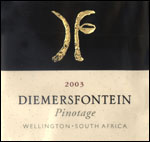![]()
Recent Articles
May. 21 - Toasting Queen Victoria ~ With Discounted Reds! ~ Grab these bargains while they last!
May.
21 - Bottle
of the Week
Putting a little spice into your Victoria Day Long Weekend
May. 14 - Sprouting Up Like Tulips ~ Excellent 2003 Whites at Vintages
May.
14 - Bottle
of the Week
2004 Terra Boa Blanco ~ A Bargain Priced Springtime White from Portugal
May. 7 - Prince Edward County's Field of Dreams ~ Long Dog Winery - No Long Shot!
Apr.
30 - Bottle
of the Week
Rosemount Shiraz on a Roll!
Apr. 23 - The Wine Glass ~ The Key to getting the most out of your wines
Apr.
23 - Bottle
of the Week
Making the Rum Transition
Apr. 16 - All we are saying is give pink a chance
Apr.
16 - Bottle
of the Week
Talus 2002 Zinfandel ~ A Zinfully Good Anti-Luddite!
Apr. 9 - Don't be screwed by a bad cork ~ Screwcaps are the answer
Apr.
9 - Bottle
of the Week
2003 Mouton Cadet Blanc ~ Canada's best selling white Bordeaux
Apr. 2 - From Fizz to Pop ~ Putting some zip into Spring
Apr.
2 - Bottle
of the Week
Underberg the Ultimate Digestif! ~ Only a full bottle will do!
Mar. 26 - Canada's #1 Wine Festival 27th ~ Vancouver Playhouse International Wine Festival
Mar.
26 - Bottle
of the Week
Smooth & Satisfying ~ A Luxury French Brandy at a Great Price!
Mar. 19 - German Classics for Easter
Mar.
19 - Bottle
of the Week
A liqueur that Grows on Trees!
Mar. 12 - Ontario's Vinous Peaks ~ Great quality directly from the wineries!
Mar.
12 - Bottle
of the Week
A Special Treat for St. Patrick's Day
Mar. 5 - Today at Vintages ~ Chardonnays starting at $8.95!
Mar.
5 - Bottle
of the Week
Cynar - A One-of-a-Kind Aperitif
Feb. 26 - Cuvée Throws a Curve Ball at Ontario's Best
Feb. 19 - A Vintages Jackpot for Shiraz Fans ~ But Slim Pinot Noir Pickings
Feb. 12 - The Apple of my Heart ~ Calvados to the Rescue
Feb. 5 - Uncovering the Best Classics Red
Jan. 29 - Ooh la la! ~ Fine French Values that Won't Break the Bank
Jan. 22 - Frisky Whisky for Robbie Burns Revellers
Jan. 15 - Pinotage Perfection ~ Exploring South Africa's Sole Indigenous Grape
Jan. 8 - Gems from Chile ~ Be selective in today's Vintages Release

Get
all the evaluations for
the February Release
Subscribe
to Vintage Assessments today
by Clicking
Here
This
not-for-profit website is dedicated to the discerning reader!
Pinotage
Perfection
Exploring
South Africa's Sole Indigenous Grape
©
Michael Vaughan 2005
National Post
Weekly Wine & Spirits Columnist
Saturday,
January 15, 2005
LIVE
WINE LINK
www.winefind.ca
(CLICK ON THE NAME - All
listings are automatically linked to the LCBO database)
If there is a product that interests you,
just click on the name below and you will instantaneously connected with
the LCBO database. The product will appear in blue and all you have to do
is click on the name again
and then the next screen will provide details along with the store search.
Just click on store search.
The number of bottles in each store is updated nightly. You should call
the store first to see if stock still remains (each store phone number is
listed).
 I
am opening my last beloved bottle of one of my favourite reds.
Miraculously it is being released in Vintages next Saturday. If had only a
single wine to drink from the entire January release, this would be it. Of
course, there is a bit of deja vu here since Diemersfontein
2003 Pinotage (995241) was originally an
unsold leftover from the Young Winemakers event held in Toronto in
November 2002. I went nuts when I first tasted it (at a mere $19.95) with
its enormous, chocolate-coffee bean nose and rich, smoky, complex flavours
dripping with freshly baked ripe black cherries.
I
am opening my last beloved bottle of one of my favourite reds.
Miraculously it is being released in Vintages next Saturday. If had only a
single wine to drink from the entire January release, this would be it. Of
course, there is a bit of deja vu here since Diemersfontein
2003 Pinotage (995241) was originally an
unsold leftover from the Young Winemakers event held in Toronto in
November 2002. I went nuts when I first tasted it (at a mere $19.95) with
its enormous, chocolate-coffee bean nose and rich, smoky, complex flavours
dripping with freshly baked ripe black cherries.
Well its
back and just as tasty and more accessible than ever with harmonious,
creamy, smoky-tinged, lush black cherry flavours. While the price has been
bumped up to $21.95, the only thing that bugs me is the small quantity
ordered - only 112 cases of six, despite the wave of rave reviews. It is
the “must buy” of the month!
Of course,
one person’s feast is another’s fodder. In the past, some have not
been overly keen on this varietal. When made from under ripe or
over-cropped grapes, Pinotage can be disappointing. Just as there are lots
of terrible tasting poorly made Chardonnay and Merlot out there, it is an
injustice to tar and feather the grape as the culprit. When it’s good,
it is very, very good indeed. And when it’s great, it is sublime. Just
ask any of the tens of thousands of Pinotage fans who have formed the
worldwide Pinotage Club (see www.pinotage.org).
 The 183-hc
Diemersfontein estate is situated in the picturesque town of Wellington, a
45-minute drive north of Cape Town in the Paarl district of the Coastal
wine region. It is owned by David Sonnenberg, whose grandfather purchased
it in 1941. Initially a fruit farm and dairy, it was not planted with
vines until 1971. The grapes were sold to other producers until just four
years ago when a new facility was custom-built and young winemaker, Bertus Fourie
was hired, who at 27 year of age handcrafted Diemersfontein’s maiden
vintage.
The 183-hc
Diemersfontein estate is situated in the picturesque town of Wellington, a
45-minute drive north of Cape Town in the Paarl district of the Coastal
wine region. It is owned by David Sonnenberg, whose grandfather purchased
it in 1941. Initially a fruit farm and dairy, it was not planted with
vines until 1971. The grapes were sold to other producers until just four
years ago when a new facility was custom-built and young winemaker, Bertus Fourie
was hired, who at 27 year of age handcrafted Diemersfontein’s maiden
vintage.
The Birth of
Pinotage
 Pinotage
is very much a newcomer to the wine scene. It was Professor Abraham
Izak Perold
(call him Papa Pinotage) who in 1925 brushed a flower of the
“Hermitage” vine (aka Cinsaut - an easy-to-grow, prolific,
disease-resistant variety from the Rhone) against a Burgundian Pinot Noir
pollen donor. We may never know whether such rampant grape sex in the
garden of his official U of Stellenbosch residence was condoned, but we do
know that four seedlings were produced from these two French
thoroughbreds.
Pinotage
is very much a newcomer to the wine scene. It was Professor Abraham
Izak Perold
(call him Papa Pinotage) who in 1925 brushed a flower of the
“Hermitage” vine (aka Cinsaut - an easy-to-grow, prolific,
disease-resistant variety from the Rhone) against a Burgundian Pinot Noir
pollen donor. We may never know whether such rampant grape sex in the
garden of his official U of Stellenbosch residence was condoned, but we do
know that four seedlings were produced from these two French
thoroughbreds.
Two years
later, when Perold moved to KWV, he abandoned his experiment, leaving the
seedlings to survive on their own. Eventually the university dispatched a
team to tidy up the overgrown garden and empty abode. That might have
meant the end to
Pinotage, except for being miraculously saved by a young lecturer.
It seems that Dr. Charlie Niehaus just happened to be cyclingpast Perold's
former residence as the clean-up squad entered the garden. Niehaus ended
up saving the four vines. For more
history, and there is a lot more, check out the South African
Pinotage website (see www.pinotage.co.za).
Growing
and Making Pinotage
Pinotage
is an early ripener and can be quite prolific. In wetter years, trellised
Pinotage vines can easily bear up to 15 tons/ha, even on dry land! For
fuller bodied wines, however, yields of 32-52 hl/ha (equivalent to 5-8
tons/ha) would be the order of the day. Also, in South Africa it is the
older bushvines that often produce the best flavours. The red soils on the
foothills of mountains with a high percentage of clay and good water
retention are ideal for unirrigated bushvines.
One
of things that makes Pinotage challenging to make is the juxtaposition of
oak on an already boldly flavoured wine. It is interesting to
discover that Bertus Fourie, whose master’s thesis
focused on red wine maturation and wood extraction, has used innerstave
methodology vs. traditional barrels.
Instead of aging in barrels, he fermented the reds in tanks fitted with very fine French innerstave. The wine also goes
through its malolactic fermentation on the innerstave after which it was
racked and then matured in contact with the oak for another 6 months after
which it was bottled.
South
Africa’s first Pinotage did not hit the shelves until 1961 with the
launch of Lanzerac
1959 Pinotage!
Early editions were a bit shaky, but in recent years, huge
improvements have been made qualitatively. As South Africa’s only
indigenous grape, it currently represents 6% of the total plantings. It is
also grown in a number of other countries, albeit in very small
quantities, including New Zealand and even California. Being such a small
piece of the world’s grape pie means that most have never heard of it.
Being so insignificant, the marketing funds required to raise this
grape’s visibility do not exist.
Pinotage
in Ontario
 Here
in Ontario, we have had 34 releases in Vintages since December 2000, many
of which have been very good (the full list and ratings are available on
the FBTI website data base). Meanwhile, LCBO general list offerings have
struggled with only three brands. At present, three different vintages are
available - 2001 to 2003. For beginners I would recommend Two
Oceans 2003 Pinotage (592378) at $9.45,
which is the youngest and least expensive. It has an intense deep purple
colour and youthful, plumy nose with hints of sandalwood, red apple and
just a touch of garrigue. It is quite well structured and dry but not
austere with plummy, red cherry flavours leaning in an international
style. For information click
here
Here
in Ontario, we have had 34 releases in Vintages since December 2000, many
of which have been very good (the full list and ratings are available on
the FBTI website data base). Meanwhile, LCBO general list offerings have
struggled with only three brands. At present, three different vintages are
available - 2001 to 2003. For beginners I would recommend Two
Oceans 2003 Pinotage (592378) at $9.45,
which is the youngest and least expensive. It has an intense deep purple
colour and youthful, plumy nose with hints of sandalwood, red apple and
just a touch of garrigue. It is quite well structured and dry but not
austere with plummy, red cherry flavours leaning in an international
style. For information click
here
 At
a few dollars more, Zonnebloem
2002 Pinotage (345306) at $13.05 would be
my first choice. With 14% alcohol, the nose shows some spiciness with
plumy, baked cherries and hints of sandalwood. It is solid, dry and quite
harmonious with rather tangy, bright dried red cherry flavours. Versatile,
showing well and at peak, it finishes with some tangy acidity. For
information click
here
At
a few dollars more, Zonnebloem
2002 Pinotage (345306) at $13.05 would be
my first choice. With 14% alcohol, the nose shows some spiciness with
plumy, baked cherries and hints of sandalwood. It is solid, dry and quite
harmonious with rather tangy, bright dried red cherry flavours. Versatile,
showing well and at peak, it finishes with some tangy acidity. For
information click
here
It is that
last thing, acidity that makes Pinotage so ageable. I blind tasted a half
bottle last April with South African wine importer/specialist Fred
Lamprecht. “How old,” he asked. “I don’t know, maybe 8
years; it’s mature but it still has some plumy, strawberry fruit,” I
replied. It turned out to be an inexpensive Oude
Libertas 1972 Pinotage that was still perfectly alive and
kicking after 32 years. My sage advice, however, is that it tastes
delicious now - don’t wait, drink it!
Upcoming:
The annual LCBO
Vintages Sale (about 130 items) will be posted on our website Friday,
January 21 (the sale starts Saturday, January 29).
2001-2002-2003-2004
Tasting Note Database
Our
tasting note database from December 31, 2000 to December 2004, covers every
Vintages release product for the past 47 months. There are more than 8,000 notes in the database data. Just enter the name of the product,
supplier name or CSPC number. Or you can search by type of wine, country
of origin, even wine agent! Nothing could be easier. Also you can get information on the agent by clicking on the
agent’s name, as well as current LCBO store inventory by clicking on
"Check
LCBO Availability", which will automatically tell you the
number of bottles at LCBO as of last night.
To
use our winefind.ca Tasting
Notes Database: click
here
|
** For All Visitors ** |
Copyright Food & Beverage Testing Institute of Canada
2005
Prior written permission is required for any form of reproduction
(electronic or other wise) and or quotation.
Contact Michael Vaughan at
mbv@total.net